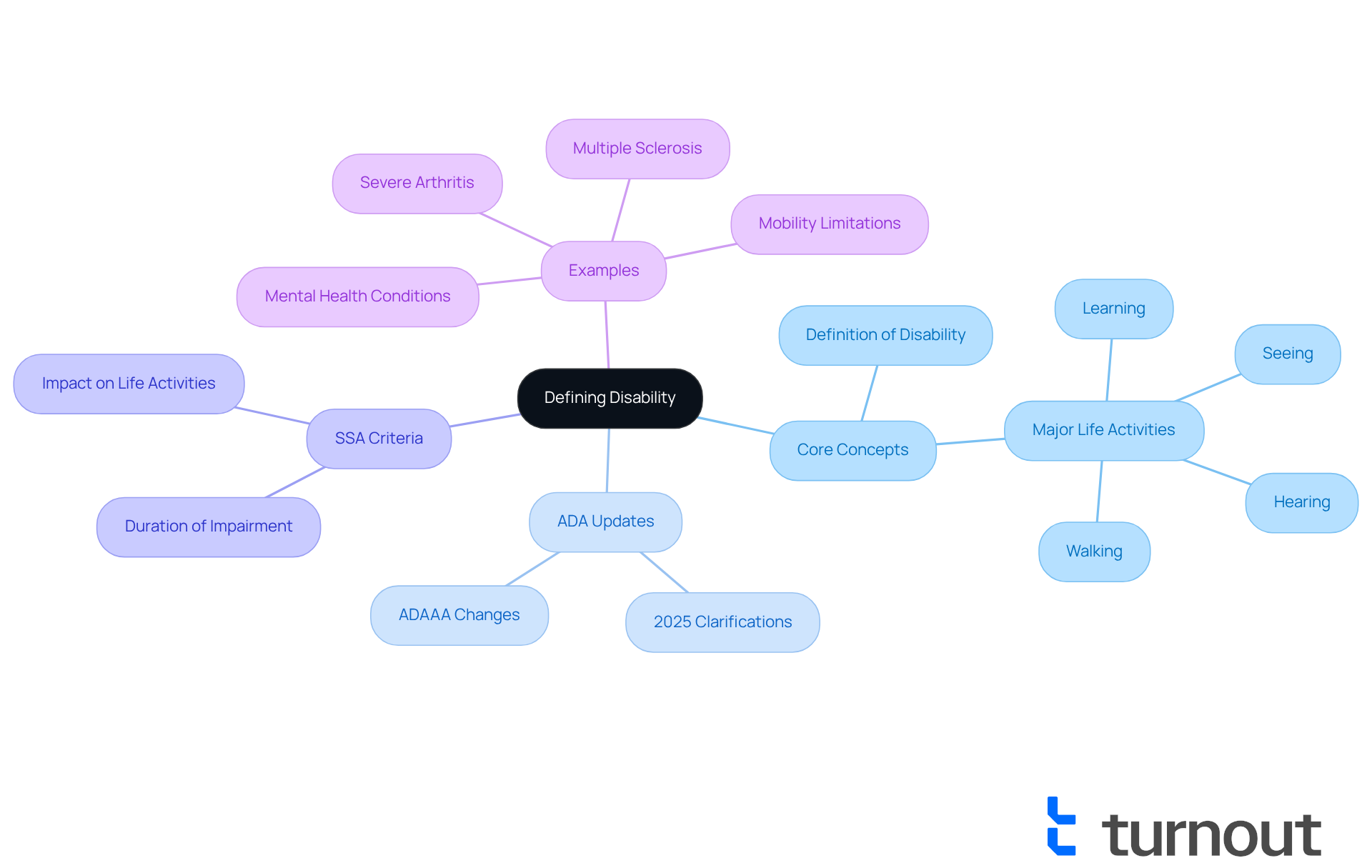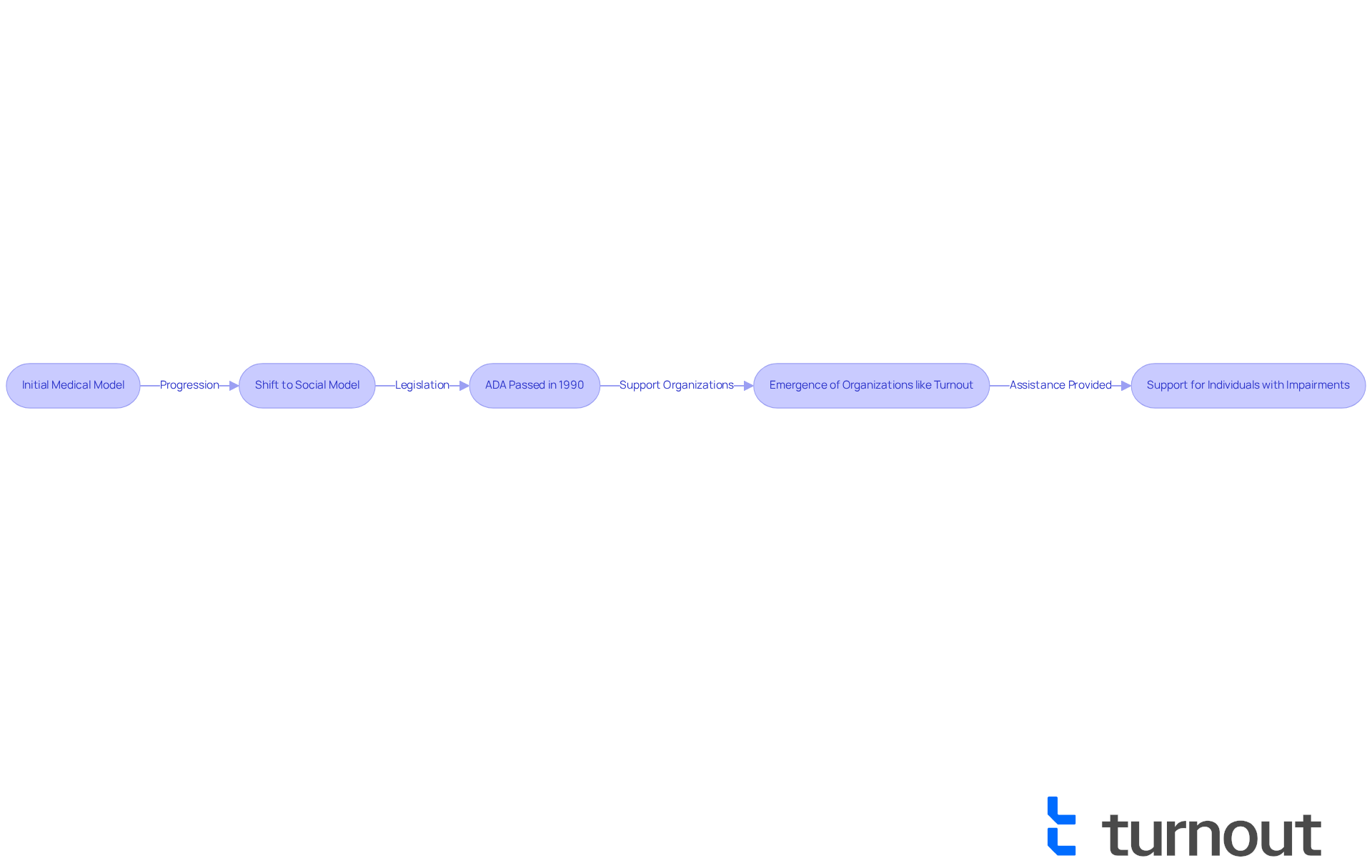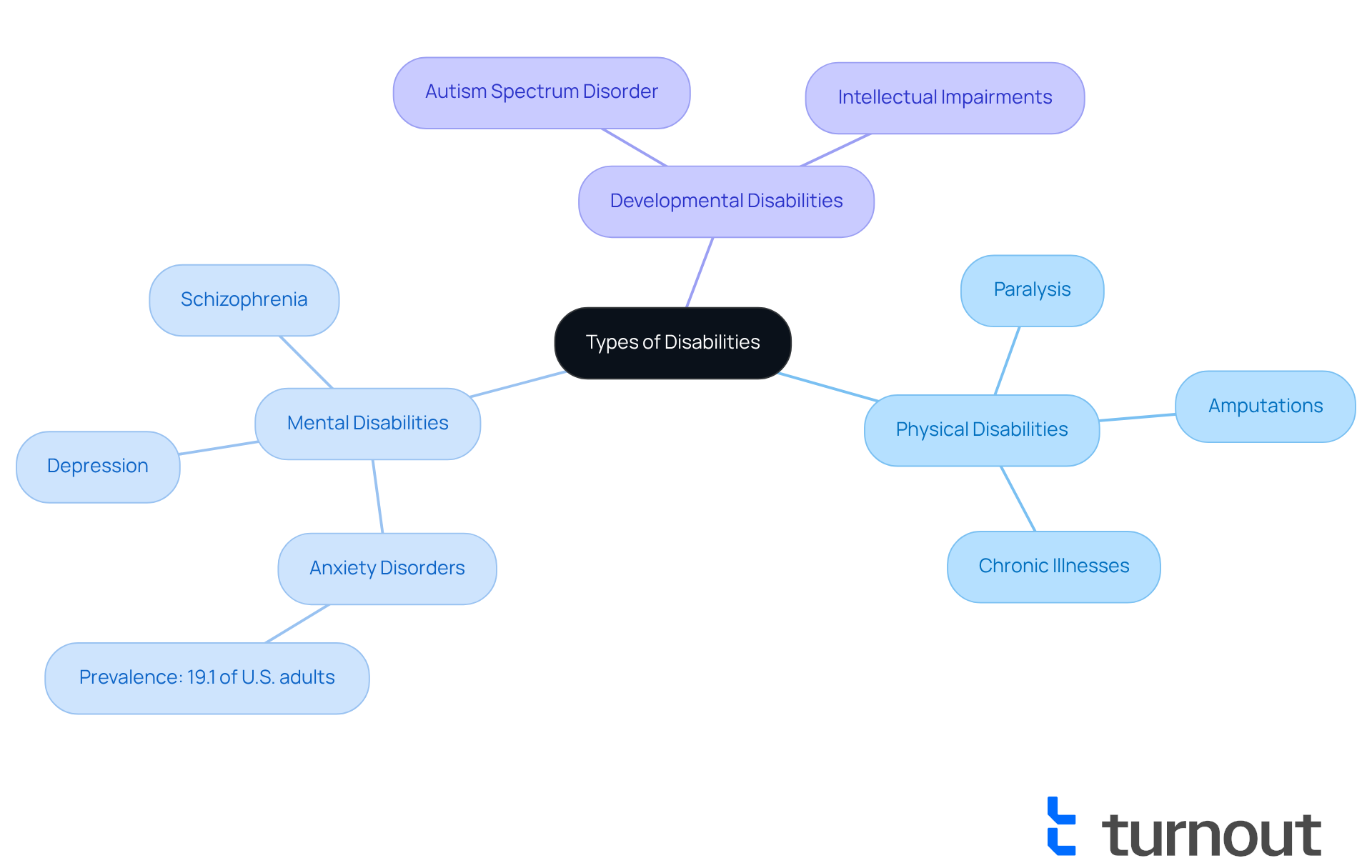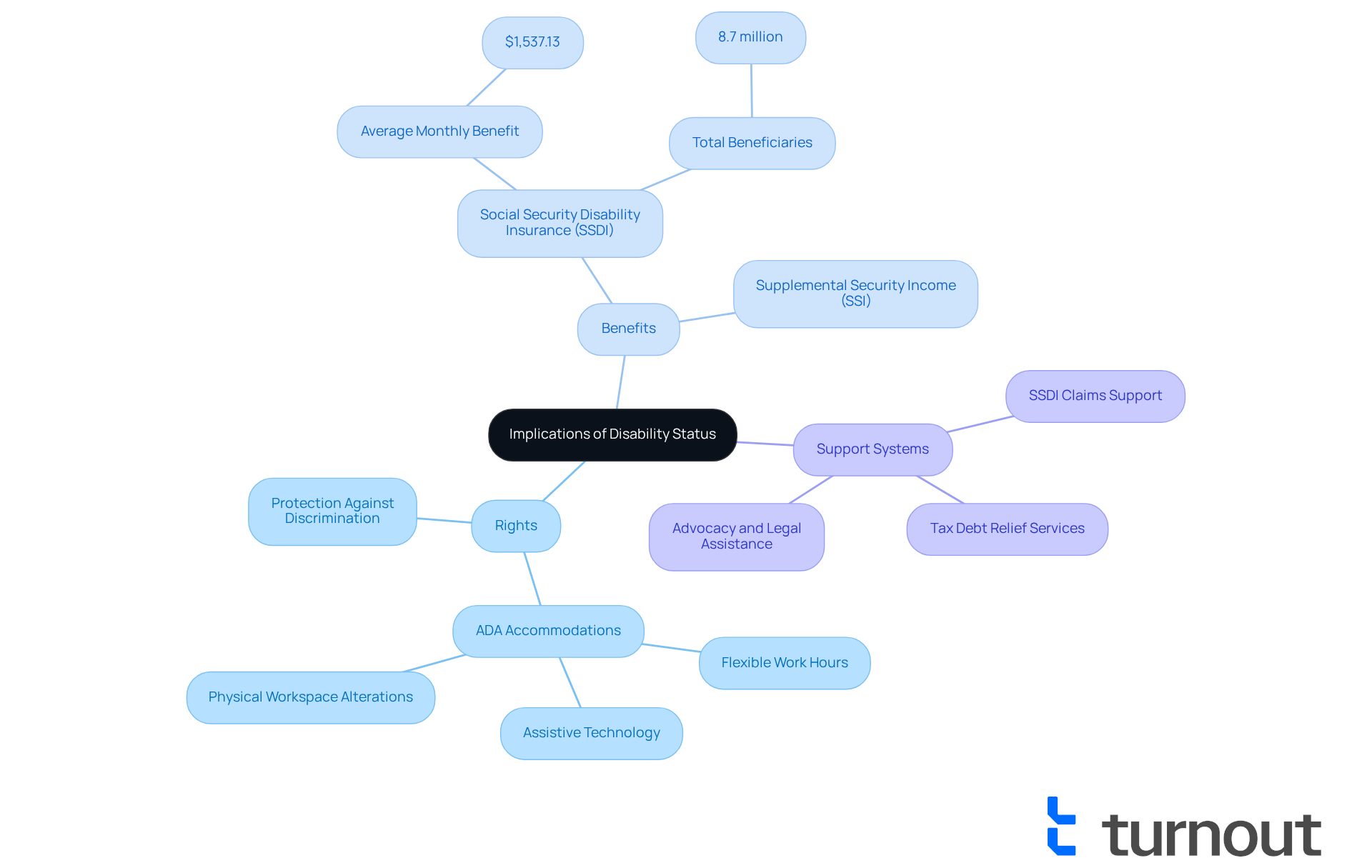Overview
Disability is defined as a physical or mental impairment that significantly limits one or more major life activities. The Americans with Disabilities Act (ADA) provides a broad framework for understanding various conditions that qualify as disabilities. We understand that navigating this landscape can be challenging, and it’s essential to have clarity on what constitutes a disability.
This article elaborates on the criteria for disability, emphasizing the importance of societal context and legal protections. It highlights the types of disabilities—physical, mental, and developmental—recognizing the unique challenges each presents. You are not alone in this journey; support systems are available to help those affected.
We encourage you to explore the resources and assistance that can make a difference in your life or the life of someone you care about. Together, we can foster understanding and create a more inclusive environment for everyone.
Introduction
Understanding what constitutes a disability is crucial in a world that increasingly values inclusivity and support for all individuals. We understand that navigating these definitions can feel overwhelming at times. With the Americans with Disabilities Act (ADA) evolving to reflect contemporary challenges, clarity around definitions and classifications is more important than ever. Readers will explore the intricacies of disability criteria, the types of impairments recognized, and the implications for rights and benefits.
How can one navigate the complexities of these definitions while ensuring access to essential support? You are not alone in this journey; we're here to help.
Defining Disability: Core Concepts and Criteria
What is considered to be a disability is defined as a physical or mental impairment that significantly limits one or more major life activities, such as walking, seeing, hearing, or learning. We understand that navigating these challenges can be overwhelming. The Americans with Disabilities Act (ADA) encompasses a broad range of conditions that affect an individual's ability to perform daily tasks, and updates to the ADA as of 2025 have clarified the definition of impairment. This ensures that it remains relevant to modern interpretations of limitations and accessibility.
According to the Social Security Administration (SSA), a condition must be anticipated to persist for a minimum of 12 months or lead to death. This requirement is essential for assessing qualification for various benefits and assistance frameworks designed to aid individuals with impairments. Currently, approximately 12.6% of Americans are classified as disabled under the ADA, highlighting a significant portion of the population that may require support. You're not alone in this journey.
Qualification for assistance related to disabilities relies on particular standards, including:
- What is considered to be a disability
- The intensity of the impairment
- Its effect on everyday activities
For instance, individuals with conditions such as severe arthritis, multiple sclerosis, or significant mental health disorders may qualify for benefits if they can demonstrate what is considered to be a disability by showing that their impairments substantially limit their ability to engage in major life activities.
Real-world examples illustrate these criteria effectively. For example, an individual with a significant mobility limitation may find it challenging to walk or carry out physical tasks, thus fulfilling the SSA's criteria for a disabling condition. Similarly, someone with a chronic mental health condition that affects their ability to learn or interact socially may also qualify for support. Comprehending these definitions and criteria is crucial for maneuvering through the intricate realm of support benefits. Remember, we're here to help you obtain the assistance you need.

Historical Context: The Evolution of Disability Definitions
The notion of impairment has undergone significant changes over the years. Initially, impairments were often viewed solely through a medical lens, focusing on the individual's limitations. However, the late 20th-century rights movement for people with impairments shifted this perspective. It highlighted the social model of challenges, which emphasizes that societal barriers, rather than personal restrictions, are the main obstacles faced by individuals with impairments.
Groundbreaking legislation, such as the ADA passed in 1990, marked a pivotal moment in recognizing the rights of people with impairments. This law established a legal framework for their protection, paving the way for greater inclusion and support. Today, organizations like Turnout play a vital role in assisting individuals with challenges. They provide essential tools and services that help navigate government processes, including:
- Social Security benefits claims
- Tax debt relief
We understand that accessing these resources can feel overwhelming. That’s why it’s crucial to ensure that the rights established by such legislation are available to those in need. You are not alone in this journey. Together, we can work towards a more inclusive society where everyone has the support they deserve.

Types of Disabilities: Physical, Mental, and Developmental Variations
Disabilities can be classified into three primary categories: physical, mental, and developmental. We understand that each type of impairment presents unique challenges that can deeply affect individuals and their loved ones. Physical impairments, such as paralysis, amputations, and chronic illnesses, can restrict mobility and everyday tasks, making daily life more difficult.
Mental health challenges encompass a broad range of conditions, including anxiety disorders, depression, and schizophrenia. These issues can significantly influence a person's daily functioning and overall quality of life. It's common to feel overwhelmed, as anxiety disorders alone affect approximately 19.1% of U.S. adults, highlighting the prevalence and significance of mental health challenges.
Developmental challenges, including autism spectrum disorder and intellectual impairments, impact cognitive and social growth. These conditions frequently necessitate tailored assistance frameworks to support individuals effectively. Each kind of impairment requires a compassionate approach for effective advocacy and support.
Grasping these distinctions is essential for cultivating an inclusive atmosphere. We’re here to help ensure that the specific requirements of people with impairments are met. Remember, you are not alone in this journey; together, we can foster understanding and support.

Implications of Disability Status: Rights, Benefits, and Support Systems
Being categorized as what is considered to be a disability can bring about significant challenges, particularly concerning your rights and access to essential benefits. We understand that navigating these complexities can be overwhelming. Under the Americans with Disabilities Act (ADA), individuals with impairments are entitled to reasonable adjustments in the workplace. These modifications may include flexible work hours, assistive technology, or physical alterations to the workspace. Such accommodations are crucial for empowering disabled individuals to perform their jobs effectively and without discrimination.
Moreover, if you meet the Social Security Administration's (SSA) criteria for disability, you may qualify for Social Security Disability Insurance (SSDI) or Supplemental Security Income (SSI). These programs provide vital financial assistance, with the average monthly amount for disabled workers reported at $1,537.13. In December 2023, over 8.7 million disabled beneficiaries received nearly $12.7 billion in benefits. This highlights the significant role these programs play in the lives of many.
Turnout offers tools and services designed to help you navigate these complex systems. Our assistance includes SSD claims support through trained nonlawyer advocates and tax debt relief with IRS-licensed enrolled agents. Grasping these implications is essential for those seeking help, as it empowers you to advocate for your rights and understand what is considered to be a disability to access available resources. Legal experts emphasize that the ADA not only protects against discrimination but also mandates that employers provide necessary accommodations. This fosters an inclusive work environment, ensuring that individuals with disabilities can navigate the workforce and society with dignity and support.
Remember, you are not alone in this journey. We’re here to help you every step of the way.

Conclusion
Understanding what constitutes a disability is essential in navigating the complexities of support and advocacy for individuals facing various challenges. We recognize that this journey can be overwhelming. The definitions and classifications of disabilities, as outlined by the Americans with Disabilities Act (ADA) and the Social Security Administration (SSA), establish a framework that not only identifies impairments but also emphasizes the rights and accommodations necessary for individuals to thrive. This comprehensive approach ensures that those affected by disabilities receive the recognition and assistance they need.
The evolution of disability definitions has shifted from a purely medical perspective to a broader social understanding that recognizes societal barriers as significant obstacles. Disabilities are categorized into physical, mental, and developmental types, each presenting unique challenges. It's common to feel uncertain about your rights, but legal protections, such as the ADA, safeguard the rights of individuals with disabilities and mandate necessary workplace accommodations. Understanding these insights is crucial for anyone seeking to know their rights and the support available to them.
Ultimately, fostering an inclusive society requires awareness and action. We encourage you to engage with advocacy organizations, understand your rights under the ADA, and seek out resources that can help navigate the often complex landscape of disability benefits and support systems. By doing so, we can move closer to ensuring that all individuals, regardless of their challenges, have access to the opportunities and support they deserve. Remember, you are not alone in this journey; we're here to help.
Frequently Asked Questions
What is considered to be a disability?
A disability is defined as a physical or mental impairment that significantly limits one or more major life activities, such as walking, seeing, hearing, or learning.
What does the Americans with Disabilities Act (ADA) encompass?
The ADA encompasses a broad range of conditions that affect an individual's ability to perform daily tasks and has been updated as of 2025 to clarify the definition of impairment, ensuring it remains relevant to modern interpretations of limitations and accessibility.
What is the duration requirement for a condition to be considered a disability by the Social Security Administration (SSA)?
According to the SSA, a condition must be anticipated to persist for a minimum of 12 months or lead to death to qualify as a disability.
What percentage of Americans are classified as disabled under the ADA?
Approximately 12.6% of Americans are classified as disabled under the ADA.
What standards are used to qualify for assistance related to disabilities?
Qualification for assistance relies on standards that include what is considered to be a disability, the intensity of the impairment, and its effect on everyday activities.
Can you provide examples of conditions that may qualify for disability benefits?
Conditions such as severe arthritis, multiple sclerosis, or significant mental health disorders may qualify for benefits if individuals can demonstrate that their impairments substantially limit their ability to engage in major life activities.
How do real-world examples illustrate the criteria for disability?
For example, an individual with significant mobility limitations may struggle to walk or perform physical tasks, fulfilling the SSA's criteria for a disabling condition. Similarly, someone with a chronic mental health condition that affects their ability to learn or interact socially may also qualify for support.




